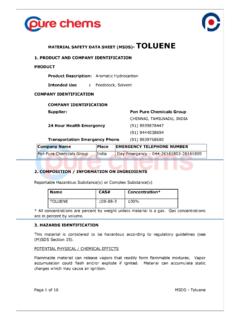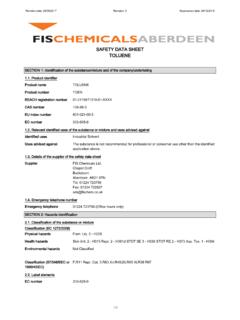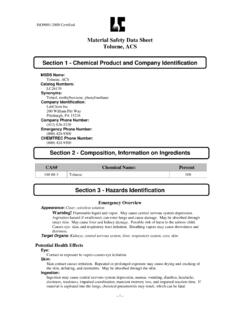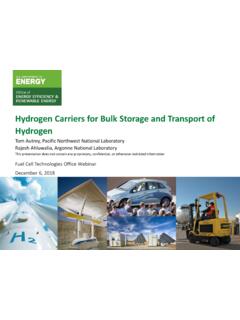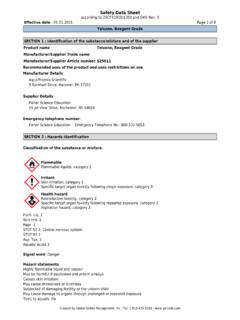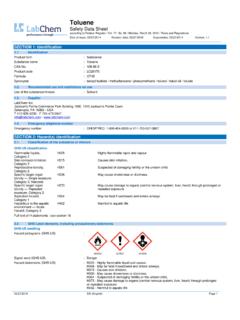Transcription of Safety Data Sheet Toluene Diisocyanate
1 The Chemical Company 44 Southwest Ave. Jamestown, RI 02835 Page 1 of 10 Safety data Sheet Toluene Diisocyanate Revision Date: 06-June-2017 Version 1. Supplier and Substance Identification Product Information Product name: Toluene Diisocyanate Description: Polyurethane component, industrial chemicals Recommended use of the chemical and restrictions on use Recommended use Plasticizer Uses advised against None known Supplier: The Chemical Company 44 Southwest Avenue Jamestown, RI 02835 USA Phone : Fax : Email : Web : For Chemical Emergency Spill, Leak, Fire, Exposure, or Accident Call CHEMTREC Day or Night Within USA and Canada: 1-800-424-9300 Outside USA and Canada: +1 703-527-3887 (collect calls accepted) 2.
2 Hazards Identification GHS-US classification Acute toxicity (inhal.), Category 1 H330 Fatal if inhaled Skin corrosion/irritation, Category 2 H315 Causes skin irritation Serious eye damage/eye irritation, Category 2A H319 Causes serious eye irritation The Chemical Company 44 Southwest Ave. Jamestown, RI 02835 Page 2 of 10 Sensitization Respiratory, Category 1 H334 May cause allergy or asthma symptoms or breathing difficulties if inhaled Sensitization Skin, Category 1 H317 May cause an allergic skin reaction Carcinogenicity, Category 2 H351 Suspected of causing cancer Specific target organ toxicity Single exposure, Category 3, Respiratory tract irritation Full text of H statements: see section 16 H335 May cause respiratory irritation Hazard pictograms (GHS-US) : Signal word (GHS-US) : Danger Hazard statements (GHS-US).
3 H315 - Causes skin irritation H317 - May cause an allergic skin reaction H319 - Causes serious eye irritation H330 - Fatal if inhaled H334 - May cause allergy or asthma symptoms or breathing difficulties if inhaled H335 - May cause respiratory irritation H351 - Suspected of causing cancer Precautionary statements (GHS-US) : P201 - Obtain special instructions before use P202 - Do not handle until all Safety precautions have been read and understood P260 - Do not breathe fume, mist, spray, vapors P264 - Wash hands thoroughly after handling P271 - Use only outdoors or in a well-ventilated area P272 - Contaminated work clothing must not be allowed out of the workplace P280 - Wear protective clothing, protective gloves, eye protection, Respiratory protection P302+P352 - If on skin: Wash with plenty of water P304+P341 - If inhaled: If breathing is difficult, remove person to fresh air and keep comfortable for breathing P305+P351+P338 - If in eyes: Rinse cautiously with water for several minutes.
4 Remove contact lenses, if present and easy to do. Continue rinsing P308+P313 - If exposed or concerned: Get medical advice/attention P312 - Call a doctor, a POISON CENTER if you feel unwell P332+P313 - If skin irritation occurs: Get medical advice/attention. According to Federal Register / Vol. 77, No. 58 / Monday, March 26, 2012 / Rules and Regulations February 10, 2017 EN (English) 2/8 P337+P313 - If eye irritation persists: Get medical advice/attention P342+P311 - If experiencing respiratory symptoms: Call a POISON CENTER P362+P364 - Take off contaminated clothing and wash it before reuse P363 - Wash contaminated clothing before reuse The Chemical Company 44 Southwest Ave. Jamestown, RI 02835 Page 3 of 10 P403+P233 - Store in a well-ventilated place.
5 Keep container tightly closed P405 - Store locked up P501 - Dis local, national and international 3. Composition/Information on Ingredients 4. First Aid Measures First-aid measures after inhalation: Immediately call a POISON CENTER or doctor/physician. Remove victim to fresh air and keep at rest in a position comfortable for breathing. If breathing is difficult, remove victim to fresh air and keep at rest in a position comfortable for breathing. If experiencing respiratory symptoms: Call a POISON CENTER or doctor/physician. First-aid measures after skin contact : Wash with plenty of soap and water. Wash contaminated clothing before reuse. If skin irritation occurs: Get medical advice/attention.
6 First-aid measures after eye contact : Rinse cautiously with water for several minutes. Remove contact lenses, if present and easy to do. Continue rinsing. If eye irritation persists: Get medical advice/attention. First-aid measures after ingestion : Rinse mouth. Do NOT induce vomiting. Get medical advice/attention if you feel unwell. Symptoms/injuries after inhalation : Fatal if inhaled. May cause allergy or asthma symptoms or breathing difficulties if inhaled. May cause respiratory irritation. Symptoms/injuries after skin contact : Causes skin irritation. May cause an allergic skin reaction. Symptoms/injuries after eye contact : Causes serious eye irritation. Symptoms/injuries after ingestion : May be harmful if swallowed.
7 May cause stomach pain or discomfort. Chronic symptoms : Suspected of causing cancer. 5. Fire Fighting Measures Suitable extinguishing media : Foam. Dry powder. Carbon dioxide. Alcohol-resistant foam. Unsuitable extinguishing media Do NOT use water. Fire hazard : Slight fire hazard when heated. Thermal decomposition products may include highly toxic hydrogen cyanide, and toxic and hazardous carbon oxides and nitrogen. Explosion hazard : May form flammable vapor-air mixture. Containers may explode and rupture when heated. The Chemical Company 44 Southwest Ave. Jamestown, RI 02835 Page 4 of 10 Reactivity : Stable, but reacts exothermically with water yielding carbon dioxide and an organic base.
8 May brown on exposure to sunlight. Toxic gas may accumulate in a closed space. Frozen at less than 15 C, and can produce dimer at high temps. Firefighting instructions : Use water spray or fog for cooling exposed containers. Exercise caution when fighting any chemical fire. Prevent fire-fighting water from entering the environment. Protective equipment for firefighters : Do not enter fire area without proper protective equipment, including respiratory protection. 6. Accidental Release Measures Emergency procedures Evacuate unnecessary personnel. Protective equipment : Equip cleanup crew with proper protection. Emergency procedures : Ventilate area. Prevent entry to sewers and public waters.
9 Notify authorities if liquid enters sewers or public waters. Methods for cleaning up : lids, such as clay or diatomaceous earth as soon as possible. Collect spillage. Store away from other materials. See Heading 8. Exposure controls and personal protection. For disposal of residues refer to section 13 : Disposal considerations. 7. Handling and Storage Precautions for safe handling : Provide good ventilation in process area to prevent formation of vapor. Do not breathe fume, mist, spray, vapors. Use only outdoors or in a well-ventilated area. Obtain special instructions before use. Do not handle until all Safety precautions have been read and hands thoroughly after handling. Contaminated work clothing should not be allowed out of the workplace.
10 Wash contaminated clothing before reuse. Handle in accordance with good industrial hygiene and Safety practice. Storage conditions : Keep only in the original container in a cool, well ventilated place away from incompatible materials and sources of heat. Keep container tightly closed. Incompatible materials : Water, acid, acyl chloride, alcohol, aluminum, amines, ammonia, aniline, strong bases, copper and copper alloys, activated hydrogen, metal, oxidizing agents, plastics, rubber coating, polyurethane, surface active agents, zinc alloy. 8. Exposure Controls/Personal Protection Appropriate engineering controls The Chemical Company 44 Southwest Ave. Jamestown, RI 02835 Page 5 of 10 Provide adequate ventilation.
